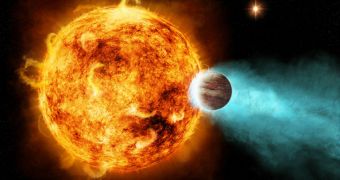The results of a new astronomical investigation demonstrate that a nearby star is drenching the surface of its host extrasolar planet with massive amounts of X-ray radiations, about 100,000 times higher than what the Sun throws at us.
This is a very significant discovery, as it paints the interactions between exoplanets and their parent stars in an entirely new light. The effects of such a harsh treatment on the smaller world are of great interest to astrophysicists, but studying the issue in depth is a very complex task.
Researchers found that the exoplanet is most likely a hot Jupiter, a gas giant-sized object that orbits its star at a distance similar to Mercury's from the Sun. Calculations have shown that the star in this particular system is between 100 and 300 million years old.
This means that it has had ample time to form, and that it is therefore a mature star. It is located an estimated 880 light-years away, say investigators behind the new study. They used the NASA Chandra X-Ray Observatory and the European Southern Observatory's Very Large Telescope, in Chile, for this study.
At any given second, the huge amounts of radiation hitting the companion planet strip as much as 5 million tons of material from its surface. The exoplanet was discovered by the French Space Agency's Convection, Rotation and planetary Transits (Corot) satellite back in 2008.
It is known as CoRoT-2b, which signifies that it occupies the first orbit around the star. “This planet is being absolutely fried by its star. What may be even stranger is that this planet may be affecting the behavior of the star that is blasting it,” expert Sebastian Schroeter explains.
The researcher, who holds an appointment with the University of Hamburg in Germany, was the lead author of a new study detailing the findings. He explains that CoRoT-2b is about three times heavier than Jupiter, the largest planet in our solar system
Chandra data seem to suggest that the level of X-ray activities on the star is more in tune with that expected from a young stellar body rather than a fully-formed one. The reason for this discrepancy has not yet been revealed, Space reports.
“Because this planet is so close to the star, it may be speeding up the star's rotation and that could be keeping its magnetic fields active,” Hamburg investigator and study coauthor Stefan Czesla adds.
“If it wasn't for the planet, this star might have left behind the volatility of its youth millions of years ago,” the researcher adds. Details of the new investigation and its results were published in the August issue of the esteemed journal Astronomy and Astrophysics.

 14 DAY TRIAL //
14 DAY TRIAL //